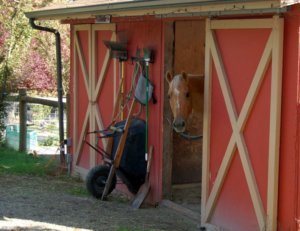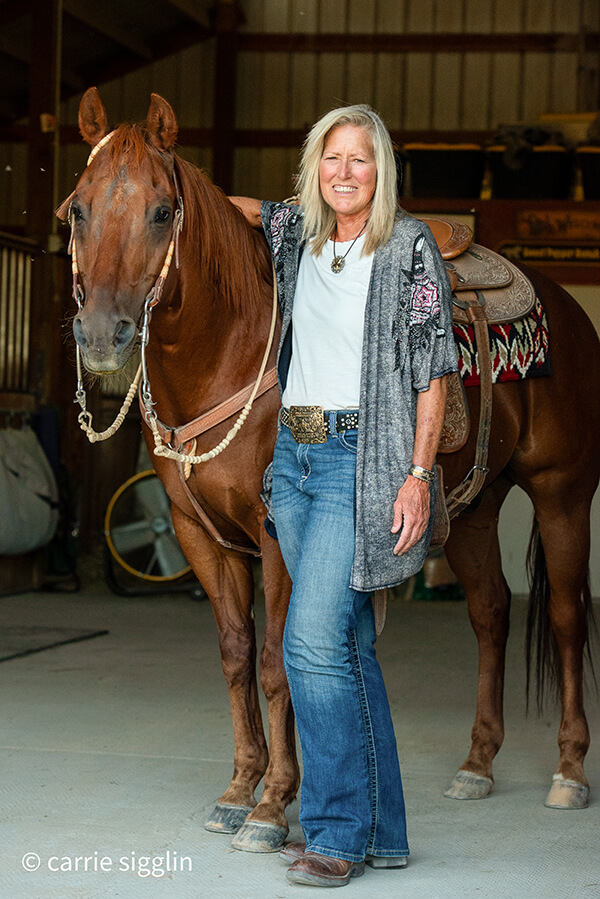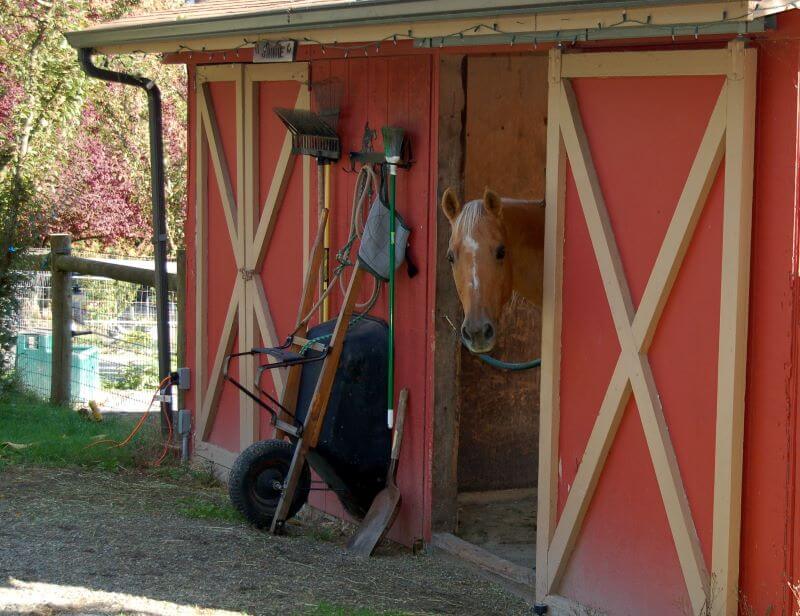Begin with the Essential Basics when Designing a Home for Your Horses
By Alayne Blickle

Providing shelter for your horse can mean anything from a tree in a pasture to a nice, big barn. In this article I will consider the basic shelter requirements. Future articles will review considerations for building a horse place and will offer resources for more building ideas.
Horses need shelter and protection from extreme heat, driving rain, and severe cold. A healthy horse can withstand cold temperatures, but when it’s windy a horse loses a considerable amount of body heat. The situation worsens when the horse is wet. Horses should be provided a place where they can get out of mud and wet for at least half the day. This can be anything from a basic run-in shed to a larger structure like a barn with stalls.
When designing your horse facility, you need to plan on a place for your horse (or horses) with storage for feed, tack and supplies, and bedding (if needed). You may be able to consider a larger design such as a barn with a tack room, shavings storage, and wash rack. However, if this scale of plans is not in your immediate future a simple shelter may be able to address your needs as well as the horse’s. Let’s break it down.
A three-sided run-in shed can provide excellent shelter and may be the most natural for a horse. This kind of structure allows a horse to regulate his body temperature, get out of the rain and wind, and it has excellent ventilation.
Closed barns accumulate dust, ammonia fumes and moisture. These conditions create an environment in which mold and germs grow. This kind of closed environment is harmful to the horse’s fragile respiratory system that was designed to breathe the clean, dry air of prairies and savannahs.
If you choose to have a barn, each stall needs air movement to keep air clean and prevent condensation — an occasional breeze down an aisleway may not be enough. Having the walls open at the top can provide additional air circulation. Cupolas may do this as well.
When choosing the location for your shelter look for a high, well-drained area. It’s advisable to check soil types before building. Gravelly soils are better drained and less likely to become muddy so they’re good locations for buildings and confinement areas. Loamy soils that retain moisture are best used for pastures. Check with your USDA Natural Resources Conservation Service or local conservation district for more information on your soil types.
Stay far away from creeks, wetlands, or ditches (especially those with water even if they are only seasonal flows). Watch for hills or sloping ground behind or near your structure that may drain into it. Be sure to locate the shelter’s open side facing away from the prevailing weather patterns so that your horse can have protection when the wind howls.
Another consideration is accessibility for people and vehicles. Is there a year-around road or driveway to your barn or shelter? You will need access for folks such as the vet and farrier as well as for hay or other deliveries.
Be sure the driveway is adequate. Will it be easy to clear of snow and ice? Are there overhead wires or trees which might be difficult for deliveries of hay or shavings? Are gates in paddocks wide enough for dump trucks doing deliveries of gravel or footing material? Can emergency vehicles access your place? Putting your shelter in the middle of a pasture or away from everything else may look aesthetically pleasing but it’s not practical.
For chore efficiency, structure your setup so deliveries can be made without moving horses. Will people have to drive through the pasture to get to barn? Can horses be fed without people walking through pastures or paddocks? This is especially important if you plan to have others feeding your horses while you’re away. Can horses be moved between paddocks or other areas with ease? Be sure that alleys and paths are wide enough for wheelbarrows or other equipment.
Utilities are another consideration. If your building plan includes power, water, sewer, or phone you need to investigate the feasibility for each. Shelters, barns, and manure storage must be located at least 100 feet from wellheads. If you’re on a septic system don’t place structures or paddocks on them. Contact your health department for help with well and septic questions.
Research county, city, or local regulations. Check building codes before you start your project. Community considerations are important as well. Manure storage facilities should be downwind from neighbors and constructed in an appropriate manner. Odors, dust, flies and noise can bother neighbors and in the long run it’s easier to avoid complaints. Consider management practices that make your place an asset to your neighborhood such as wildlife enhancement techniques, preserving trees, and good pasture management.
Check out the Horses for Clean Water website for the latest on upcoming events including online classes, tip sheets, and information about our spectacular Sweet Pepper Ranch Cowgirl Retreats!
Published September 2019 Issue

Alayne Blickle began in the 1990’s as a pioneer in water conservation and natural resources conservation by creating the entrepreneurial consulting business, Horses for Clean Water, an award-winning internationally acclaimed education program that looks for horse-healthy, nature-based solutions to land management challenges. She continues this work today partnering with agencies, organizations, and horse owners throughout North America and worldwide. She is a regularly contributing writer and photojournalist to several equine publications.
Alayne lives with her horse trainer husband, Matt Livengood, in southwestern Idaho where they raise and train AQHA horses and mustangs on their eco-friendly horse ranch. Contact her through the Horses for Clean Water website or through their ranch website Sweet Pepper Ranch.
For more information contact Alayne at [email protected] or 206-909-0225.






